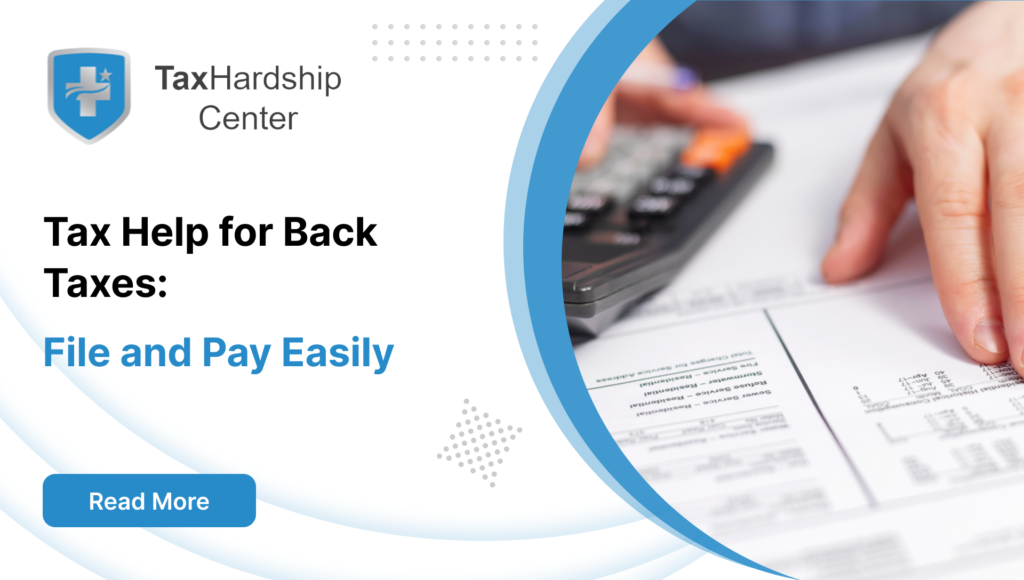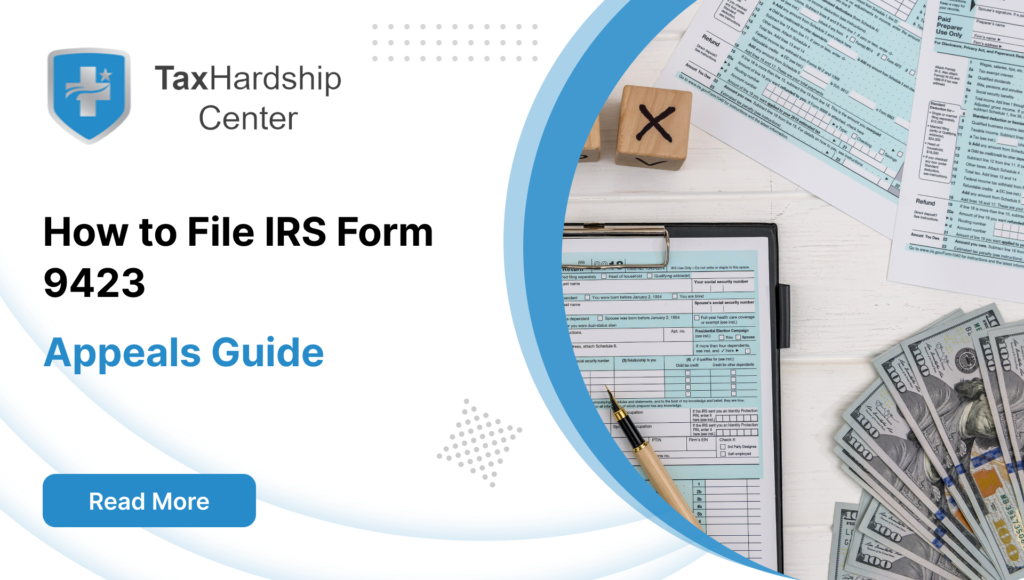For many Americans, the stress of tax debt can be overwhelming. The fear of aggressive IRS collection actions, such as wage garnishments or liens, can lead to sleepless nights and continuous anxiety. However, there is a potential lifeline for individuals facing insurmountable tax burdens: Currently Not Collectible (CNC) status. This article provides a comprehensive analysis of CNC status, exploring the key factors, trade-offs, challenges, and the importance of this relief option for those grappling with tax debt stress.
Secure Your Financial Freedom with Tax Hardship Center’s CNC Assistance
Need help with overwhelming tax debt and seeking relief? Look no further than Tax Hardship Center, a premier tax resolution firm serving all 50 states across the USA. Our expert team specializes in helping individuals like you secure Currently Not Collectible (CNC) status, providing the breathing room necessary to regain financial stability without the pressing fear of IRS collection activities.
With a steadfast commitment to our client’s financial well-being, we’re proud to offer a 14-day money-back guarantee, ensuring you can confidently trust us. Don’t let tax debt control your life any longer—schedule a free consultation with Tax Hardship Center today and take the first step towards a fresh financial start!
Eligibility For Currently Not Collectible Status
Eligibility for Currently Not Collectible (CNC) status is based on taxpayers’ financial situation. The Internal Revenue Service (IRS) will grant CNC status when it determines taxpayers cannot pay their tax debt without experiencing financial hardship. Below are vital pointers and explanations for understanding the eligibility criteria:
1. Evidence of Financial Hardship:
After covering essential living expenses, taxpayers must prove they need more financial capacity to pay their tax debt.
2. Completion of Required Documentation:
Taxpayers must fill out and submit Form 433-A (Collection Information Statement for Wage Earners and Self-Employed Individuals), Form 433-F (Collection Information Statement), or Form 433-B (Collection Information Statement for Businesses) where applicable. These forms require detailed information about income, expenses, assets, and liabilities.
3. Substantiation of Assets and Income:
The IRS will require documentation to support the entries made in the Collection Information Statements, such as bank statements, pay stubs, rent receipts, and utility bills, to ensure transparency and accuracy in the reported financial status.
4. Filing of All Tax Returns:
Taxpayers must be up-to-date when filing their tax returns. The IRS generally requires filing all back taxes to understand the taxpayer’s total liability clearly.
5. Minimum Income Threshold:
There is no set income threshold for CNC status, as it depends on the individual’s financial situation. However, the IRS uses national and local standardized expense figures to determine if taxpayers can pay. You may be more likely to qualify if your income is below these figures.
6. Evaluation of Living Expenses:
The IRS allows for necessary living expenses, which do not include credit card payments, unsecured loan payments, or non-essential costs. Living expenses include food, clothing, housing, utilities, transportation, and healthcare.
7. Lack of Equity in Assets:
The IRS assesses if there is equity in any assets that could be utilized to pay off the debt. A lack of equity (less than $10,000, for example) would likely bolster the case for CNC status.
8. Ongoing Tax Compliance:
To qualify for CNC, taxpayers must comply with their current tax obligations. This means that you should continue to file returns and, if applicable, make estimated tax payments.
9. Duration of Financial Hardship:
Temporary hardships are often a prerequisite for CNC; however, if the IRS believes your financial situation will improve significantly shortly, they might not grant CNC status.
10. No Mandatory Collection Potential:
CNC status may not be granted if the IRS believes enforced collection action will not induce hardship but will likely yield funds toward the tax debt. The IRS uses a tool known as the Collection Potential formula to estimate the amount that could be collected forcefully without causing hardship.
Understanding these pointers is essential when considering applying for CNC status. It is also important to consult a tax professional who can provide guidance tailored to your unique financial situation.
Expanding on the Relief Offered by Currently Not Collectible Status
When taxpayers are in a financial bind and unable to pay their outstanding tax debts, the Currently Not Collectible (CNC) status can serve as a critical respite. This status effectively pauses the collection process, granting individuals a much-needed period to stabilize their financial circumstances without the looming threat of the IRS initiating collection activities such as levies or garnishments.
However, it’s essential to recognize that CNC status does not equate to debt forgiveness. Your tax liability remains intact. While in CNC status, your unpaid taxes will continue to accrue interest and late payment penalties, causing the balance to grow over time. Taxpayers need to understand the long-term implications of this accruing debt even as they benefit from short-term relief.
Another aspect of CNC status is the IRS’s authority to apply a refund offset. Any future tax refunds you are due will be automatically applied to your outstanding tax debt until fully paid off. This policy can affect long-term financial planning, as any anticipated tax refunds will not be available for personal use or investment.
In addition, the IRS may place a Notice of Federal Tax Lien against your property when you owe a significant tax debt. A tax lien is a public document that alerts creditors about the IRS’s legal right to your property. This can adversely affect your credit score, making it more difficult to obtain loans or refinance existing debts, and it may impact your ability to sell or leverage assets like real estate.
Seeking professional assistance from a tax expert is highly recommended when considering CNC status. A tax professional can comprehensively evaluate your financial situation to determine if CNC status is the most suitable approach. They will explore various options available for managing your tax debt, including setting up an installment agreement, which allows you to make monthly payments towards your debt, or proposing an Offer in Compromise (OIC), where you may settle your debt for less than the total amount owed if you can demonstrate that you’re unable to pay the total balance.
Both installment agreements and OICs, like CNC status, require detailed financial information to determine your ability to pay. Tax professionals will use this data to calculate feasible monthly installment payments and estimate a realistic settlement amount for an OIC. They will also review your qualifications for CNC status based on this information.
Consider a hypothetical scenario where you are 65 with an eight-year-old tax debt, and you earn $30,000 a year. After taxes, your income just covers your rent, utilities, groceries, and a monthly bus pass. A tax professional might review your situation and find that after accounting for basic living expenses, there is no disposable income left to pay the tax debt. In this case, the IRS may determine your eligibility for CNC status based on financial hardship, ensuring that your necessary living expenses are prioritized over tax debt repayment.
In summary, while CNC status can offer temporary relief from the stress of tax debt collection, it’s essential to consider its advantages and potential long-term financial consequences. Tax professionals play a crucial role in helping you navigate these complexities, ensuring that you choose the best course of action for your circumstances.
Expanding on the Process of Applying for CNC Status
When an individual is struggling with tax debt and considering the possibility of obtaining Currently Not Collectible (CNC) status, it’s essential to understand the process and what the IRS will require from the taxpayer. Here’s a detailed look at the steps involved and what to expect while applying for CNC status:
1. Filing Past Due Returns:
The IRS insists on compliance with filing requirements as a prerequisite for considering any tax relief measure. If you have past-due returns, the IRS will likely require you to file them before processing your CNC status application. This step is critical because it allows the IRS to assess your tax liability. It is also a good-faith effort on the taxpayer’s part to show compliance with tax laws.
2. Completing Collection Information Statements:
The IRS uses Collection Information Statements to evaluate a taxpayer’s financial situation. These forms serve as a detailed account of taxpayers’ income, expenses, assets, and liabilities.
- Form 433-A: Collection Information Statement for Wage Earners and Self-Employed Individuals is typically used by individuals to report personal financial details.
- Form 433-F: Collection Information Statement is a simplified version often used in cases requiring less detailed information.
- Form 433-B: Collection Information Statement for Businesses is used for business entities to report their financial situation.
Completing these forms accurately is essential as they allow the IRS to determine whether a taxpayer can pay the tax debt. Only accurate or complete information may lead to delays or denial of CNC status.
3. Providing Verification:
The IRS will not just take your word for it; they will request documentation to verify the information provided on your Collection Information Statements. This documentation may include bank statements, pay stubs, bills, loan agreements, and other relevant financial records. This verification ensures that all information is accurate and taxpayers can only pay the tax debt with enduring financial hardship.
4. Penalties and Interest Accrual:
Even though CNC status can halt active collection efforts, the accrual of monthly late payment penalties and interest on the outstanding tax debt continues. Taxpayers should be aware that their liability will continue to grow even while they are not making payments.
5. Compliance with Ongoing Tax Obligations:
Obtaining CNC status does not absolve taxpayers of their ongoing tax responsibilities. The IRS will require taxpayers to continue to make all current Estimated Tax Payments (for individuals) and Federal Tax Deposits (for businesses). Staying compliant with current tax obligations is crucial, and failure to do so may result in the revocation of CNC status and the resumption of collection activities.
It’s essential for taxpayers to meticulously follow these steps and provide thorough documentation when applying for CNC status.
Understanding IRS Closing Codes and CNC Status Reviews
When the Internal Revenue Service (IRS) approves a taxpayer for Currently Not Collectible (CNC) status, it assigns a closing code to their account. This code is a crucial administrative marker the IRS uses to monitor the taxpayer’s account and determine the appropriate times to reevaluate their financial situation.
The closing code system acts as a trigger, correlating to the taxpayer’s annual income. It alerts the IRS to review the account once the taxpayer’s reported income exceeds a certain threshold, suggesting an improved financial capacity to pay the outstanding tax debt. For instance, if the IRS grants you CNC status when your income is $30,000, a closing code may be established to flag your account for review if your reported income rises to $36,000.
As a taxpayer, you must inquire about the specific closing code applied to your account during the CNC setup. Understanding this code will give you insight into what income level will prompt the IRS to initiate a follow-up. This information is not just of administrative importance—it can also help you plan your finances and anticipate when you may need to reassess your options for tax debt resolution.
The time you can maintain your CNC status is closely linked to your income level and the pace at which your financial situation improves. CNC status isn’t permanent; it’s intended as a reprieve when you cannot afford your tax payments without experiencing hardship.
The IRS considers several types of income when determining CNC status, including:
- Wages: Income from employment, both full-time and part-time.
- Interest: Earnings from savings accounts, investments, or other interest-bearing assets.
- Dividends: Payments received from investments in stocks or mutual funds.
- Schedule C net profits: Income from self-employment or freelance work after deducting business expenses.
- Schedule F net profits: Income from farming operations after costs.
- Distributions: Money received from pensions, annuities, or retirement accounts.
- Other income: Any other forms of income not specifically categorized above.
The IRS sets specific allowances for living expenses based on collection financial standards. These are national and local averages for basic living costs and are intended to reflect a reasonable standard of living. There are four sets of expense categories considered:
- Food, Clothing, and Other Household Expenses include groceries, apparel, and general household supplies.
- Out-of-Pocket Health Care Expenses: Medical services, prescriptions, and health insurance costs not covered by insurance or other programs.
- Housing and Utilities: Expenses for mortgage or rent, property taxes, necessary repairs, insurance, and essential utilities.
- Transportation: Includes vehicle payments, insurance, fuel, maintenance, public transportation fees, and other transportation costs.
The IRS uses these standards to determine allowable living expenses and will not allow deductions for costs exceeding these standards. For example, suppose you are single and paying $6,000 monthly rent, but the IRS standard for housing and utilities in your city is $2,000 for a one-bedroom apartment. In that case, the IRS will only allow a deduction of $2,000 for rent when evaluating your CNC eligibility.
This system ensures that taxpayers cannot claim exorbitant living expenses to qualify for CNC status, creating a more equitable approach to determining who truly needs tax relief due to financial constraints.
Conclusion
Tax debt can be a significant source of stress for many Americans, leading to anxiety and fear of aggressive IRS collection actions. However, Currently Not Collectible (CNC) status offers a potential lifeline for individuals facing insurmountable tax burdens. By understanding the eligibility criteria, relief provided, and the application process for CNC status, taxpayers can navigate their tax debt stress more effectively and seek appropriate assistance to manage their financial situation.
Why Tax Hardship Center?
1. Hassle-Free Assistance:
Say goodbye to sleepless nights and endless tax-related stress. At the Tax Hardship Center, we believe in simplifying the complex. Our team of experts is dedicated to guiding you through every step of the process, ensuring that your tax concerns are met with precision and care.
2. 14-Day Money Back Guarantee:
We’re so confident in our ability to ease your tax worries that we offer a 14-day money-back guarantee. If, for any reason, you’re not satisfied with our service, we’ll gladly refund your investment. Your peace of mind is our top priority!
3. Free Consultation:
Are you curious about how we can transform your tax experience? Book a free consultation now! Our team will assess your situation, answer your questions, and provide free insights tailored to your needs.
4. Nationwide Coverage:
No matter which corner of the United States you call home, the Tax Hardship Center covers you. We proudly serve all 50 states, bringing our expertise to your doorstep. Wherever you are, our commitment to excellence follows.
FAQs
1. What is Currently Not Collectible (CNC) status, and how does it help individuals with tax debt?
Currently Not Collectible status is a relief option the IRS offers taxpayers who can only pay their tax debt if they experience financial hardship. It effectively pauses IRS collection actions such as wage garnishments or liens, providing individuals with a period to stabilize their financial circumstances.
2. How do I qualify for Currently Not Collectible (CNC) status?
Eligibility for CNC status is based on taxpayers’ financial situation, including evidence of financial hardship, completion of required documentation (Forms 433-A, 433-F, or 433-B), substantiation of assets and income, filing of all tax returns, minimum income threshold considerations, evaluation of living expenses, lack of equity in assets, ongoing tax compliance, and duration of financial hardship.
3. What are the trade-offs and challenges of Currently Not Collectible (CNC) status?
While CNC status provides temporary relief from IRS collection actions, it does not forgive tax debt. The unpaid taxes continue to accrue interest and penalties, and any future tax refunds may be applied to the outstanding debt. Additionally, the IRS may place a Notice of Federal Tax Lien against your property, affecting your credit score and financial flexibility.
4. How do I apply for Currently Not Collectible (CNC) status?
The application process for CNC status involves filing past due tax returns, completing Collection Information Statements (Forms 433-A, 433-F, or 433-B), verifying financial information, and ensuring compliance with ongoing tax obligations. Seeking assistance from a tax professional is recommended to navigate the application process effectively.
5. How does the IRS monitor the Currently Not Collectible (CNC) status, and what factors can prompt a review?
The IRS assigns a closing code to the taxpayer’s account when granting CNC status, which correlates to the taxpayer’s reported income. This closing code triggers a review if the taxpayer’s reported income exceeds a certain threshold, indicating an improved financial capacity to pay the tax debt. Compliance with IRS standards for living expenses also influences CNC status reviews.








